Discover 35 hidden attractions, cool sights, and unusual things to do in Reading (United Kingdom). Don't miss out on these must-see attractions: Mapledurham Watermill, Forbury Gardens, and Reading Abbey. Also, be sure to include Clayfield Copse in your itinerary.
Below, you can find the list of the most amazing places you should visit in Reading (England).
Table of Contents
Mapledurham Watermill
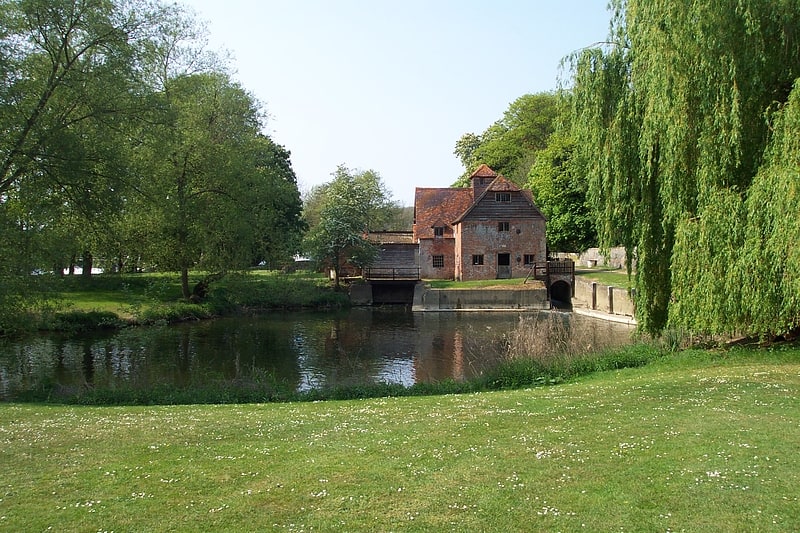
Museum in Mapledurham, England. Mapledurham Watermill is a historic watermill in the civil parish of Mapledurham in the English county of Oxfordshire. It is driven by the head of water created by Mapledurham Lock and Weir, on the River Thames. The mill was built in the 15th century, and further extended in the 17th, 18th and 19th centuries. It is a Grade II* listed building and is preserved in an operational state.
The mill also houses a micro hydro-electric power station, using a 3.6-metre (12 ft) Archimedes' screw turbine to generate electricity for sale to the National Grid. The turbine produces some 83.3 Kilowatts, which is sufficient to power about 140 homes.[1]
Forbury Gardens
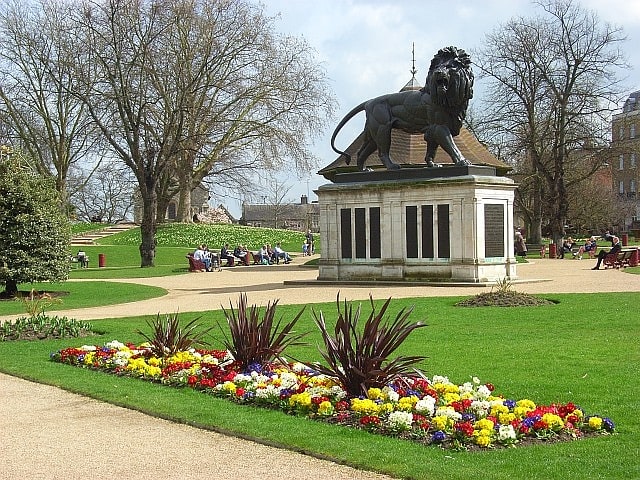
Park in Reading, England. Forbury Gardens is a public park in the town of Reading in the English county of Berkshire. The park is on the site of the outer court of Reading Abbey, which was in front of the Abbey Church. The site was formerly known as the Forbury, and one of the roads flanking the current gardens is still known as The Forbury. Fairs were held on the site three times a year until the 19th century.
The gardens are listed as Grade II in the English Heritage Register of Historic Parks and Gardens.
Forbury, a suburb of the New Zealand city of Dunedin, was named after the gardens by early resident William Henry Valpy, who was born in Reading.[2]
Address: The Forbury, Forbury Rd, RG1 3BB Reading
Reading Abbey
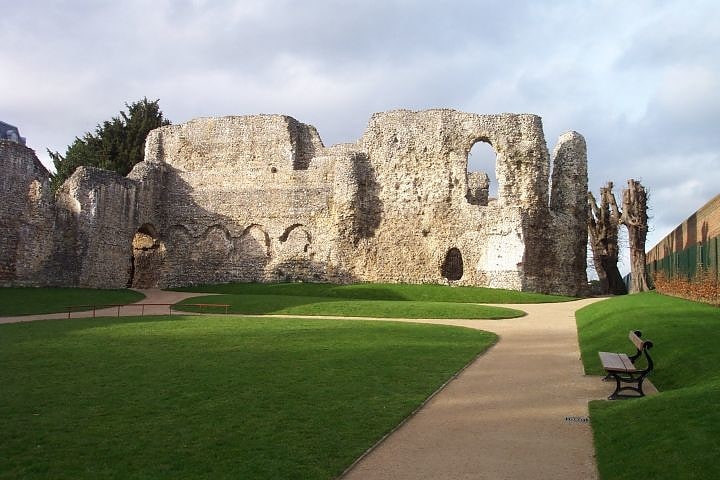
Extensive medieval abbey ruins. Reading Abbey is a large, ruined abbey in the centre of the town of Reading, in the English county of Berkshire. It was founded by Henry I in 1121 "for the salvation of my soul, and the souls of King William, my father, and of King William, my brother, and Queen Maud, my wife, and all my ancestors and successors." In its heyday the abbey was one of Europe's largest royal monasteries. The traditions of the Abbey are continued today by the neighbouring St James's Church, which is partly built using stones of the Abbey ruins.
Reading Abbey was the focus of a major £3 million project called "Reading Abbey Revealed" which conserved the ruins and Abbey Gateway and resulted in them being re-opened to the public on 16 June 2018. Alongside the conservation, new interpretation of the Reading Abbey Quarter was installed, including a new gallery at Reading Museum, and an extensive activity programme.
Abbey Ward of Reading Borough Council takes its name from Reading Abbey, which lies within its boundaries. Now HM Prison Reading is on the site.[3]
Clayfield Copse
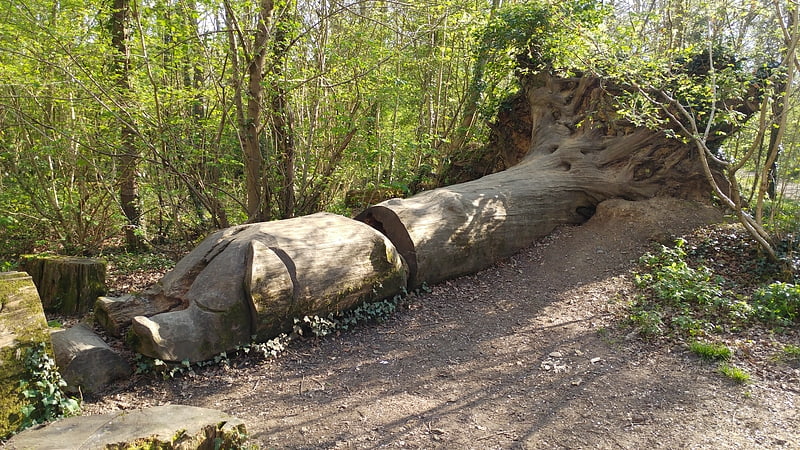
Clayfield Copse is a local nature reserve on the northern edge of the suburb of Caversham in Reading, UK. The site is 8.65 hectares in size and is a natural open space consisting of fields, wild flower meadow and native woodlands adjoining the Oxfordshire countryside. Some of the woodland is being actively managed as hazel coppice, and traditional dead hedging defines some of the ancient woodland areas. The site is the only outcrop of London Clay north of the River Thames in Reading and makes up the southern tip of the Chiltern Hills. The nature reserve is under the management of the Reading Borough Council.
The site also features a sculpture trail.[4]
Basildon Park

Georgian manor with parkland and a garden. Basildon Park is a country house situated 2 miles south of Goring-on-Thames and Streatley in Berkshire, between the villages of Upper Basildon and Lower Basildon. It is owned by the National Trust and is a Grade I listed building. The house was built between 1776 and 1783 for Sir Francis Sykes and designed by John Carr in the Palladian style at a time when Palladianism was giving way to the newly fashionable neoclassicism. Thus, the interiors are in a neoclassical "Adamesque" style.
Never fully completed, the house passed through a succession of owners. In 1910 it was standing empty and in 1914, it was requisitioned by the British Government as an army convalescent hospital. It was again sold in 1928 and quickly sold again. In 1929, following a failed attempt to dismantle and rebuild the house in the USA, it was stripped of many of its fixtures and fittings and all but abandoned.
During World War II, the house was again requisitioned and served as a barracks, a training ground for tanks, and finally a prisoner of war camp—all activities unsuited to the preservation of an already semi-derelict building. In 1952, a time when hundreds of British country houses were being demolished, it was said of Basildon Park "to say it was derelict, is hardly good enough, no window was left intact and most were repaired with cardboard or plywood."
Today, Basildon Park is as notable for its mid-twentieth-century renaissance and restoration, by Lord and Lady Iliffe, as it is for its architecture. In 1978, the Iliffes gave the house, together with its park and a large endowment for its upkeep, to the National Trust in the hope that "The National Trust will protect it and its park for future generations to enjoy."[5]
Address: Lower Basildon, RG8 9NR Reading
Madejski Stadium

Stadium in Reading, England. The Madejski Stadium, is a football stadium in Reading. It is the home of Reading Football Club, who play in the EFL Championship. It also provides the finish for the Reading Half Marathon. It is an all-seater bowl stadium with a capacity of 24,161 and is located close to the M4 motorway. The West Stand contains the voco Reading Hotel, formerly known as the Millennium Madejski Hotel.
The stadium was opened on 22 August 1998 and replaced Elm Park as Reading's home ground.[6]
Address: Shooters Way, RG2 0FL Reading
Wellington Country Park
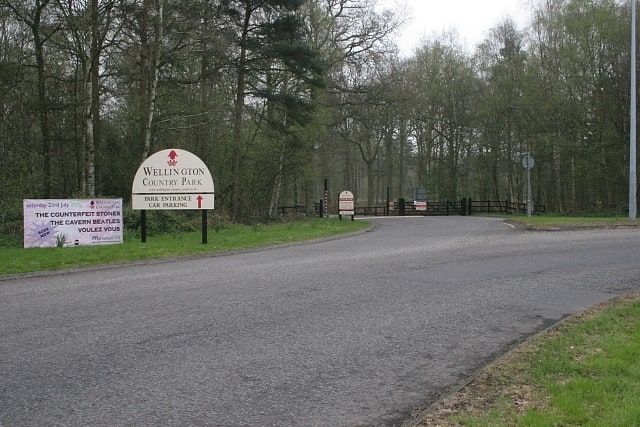
Tourist attraction in England. Wellington Country Park is a country park in Riseley, near Reading.[7]
Address: Odiham Rd, Riseley, Reading
Maiwand Lion
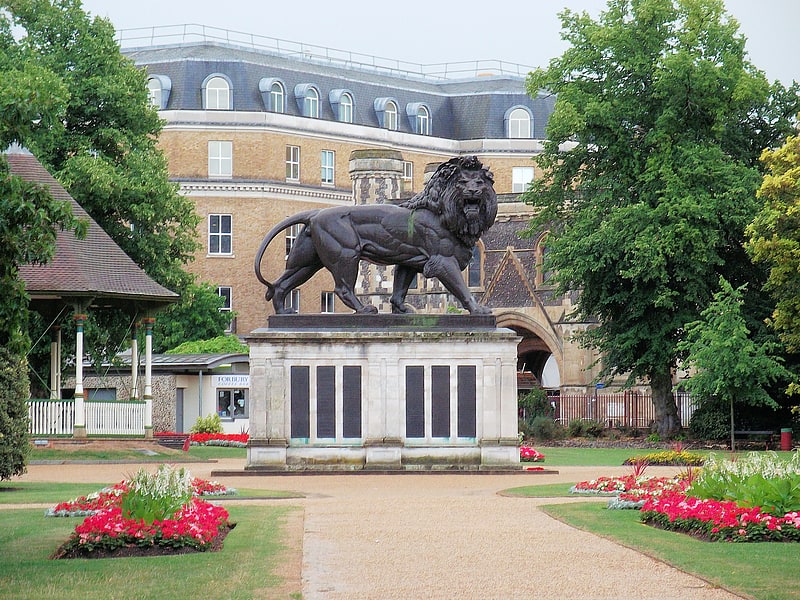
Sculpture by George Blackall Simonds. The Maiwand Lion is a sculpture and war memorial in the Forbury Gardens, a public park in the town of Reading, in the English county of Berkshire. The statue was named after the Battle of Maiwand and was unveiled in December 1886 to commemorate the deaths of 329 men from the 66th Regiment of Foot during the campaign in the Second Anglo-Afghan War in Afghanistan between 1878 and 1880. It is sometimes known locally as the Forbury Lion.
The inscription on the plinth reads as follows:
This monument records the names and commemorates the valour and devotion of XI officers and CCCXVIII non-commissioned officers and men of the LXVI Berkshire Regiment who gave their lives for their country at Girishk Maiwand and Kandahar and during the Afghan Campaign MDCCCLXXIX – MDCCCLXXX."History does not afford any grander or finer instance of gallantry and devotion to Queen and country than that displayed by the LXVI Regiment at the Battle of Maiwand on the XXVII July MDCCCLXXX."Despatch of General Primrose.
The regiment lost approximately 258 men out of 500 (reports of the number vary, see the statue inscription total above) at the battle of Maiwand, having faced an Afghan army ten times larger than the British contingent. Eleven of the men, protecting the colours, made such a brave stand before their deaths that the Afghans who fought them reported it with great respect. Sir Arthur Conan Doyle based his character Doctor Watson on the regiment's Medical officer, Surgeon Major A F Preston, who was injured in battle.
The sculptor was George Blackall Simonds, a member of a Reading brewing family from Simonds' Brewery. The sculpture took two years to design and complete, and the lion is one of the world's largest cast iron statues. Rumours persist that Simonds committed suicide on learning that the lion's gait was incorrectly that of a domestic cat. In fact, he made careful observations on lions at London Zoo and the stance was anatomically correct. He also lived for another 43 years, enjoying continuing success as a sculptor and later creating a statue of Queen Victoria (1887) and a statue of George Palmer (1891). He retired from sculpting in 1903 and worked in the family business, eventually becoming its chairman in 1910. In 1922 he temporarily came out of retirement to build the Bradfield war memorial, commemorating the deaths in the First World War of those in the 2nd Battalion, South Wales Borderers, which included his son.
The Maiwand Lion featured on the front page of one of the local newspapers, the Reading Post, prior to the publication's closure in 2014; it also appears on the Reading Football Club crest. Its face featured on the medal given to the 15,000 finishers at the Reading Half Marathon race in 2016.
The statue is made of cast iron and weighs 16 tons. It was cast by H. Young & Co. of Pimlico in 1886 and was originally supported on a terracotta pedestal. This was replaced with Portland stone in 1910 when the terracotta showed signs of cracking under the statue's weight. The rectangular pilastered plinth carries tablets recording the names of the dead, together with inscription above. The whole monument is listed grade II by English Heritage.
The Loddon Brewery, located in Dunsden Green close to Reading, brew an IPA called Forbury Lion.[8]
County Lock
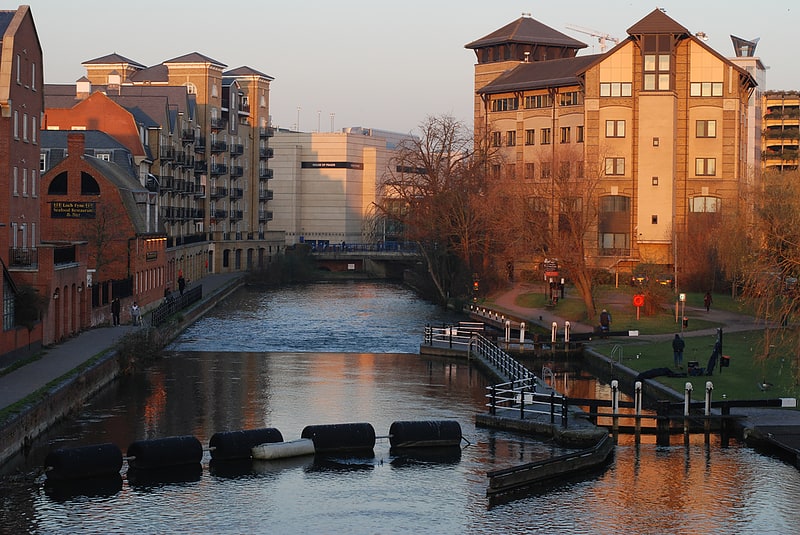
Tourist attraction in Reading, England. County Lock is a lock on the River Kennet in Reading town centre in the English county of Berkshire. It is now administered by the Canal & River Trust as part of the Kennet and Avon Canal. Downstream from the lock is Brewery Gut, a particularly fast flowing, narrow and dangerous stretch of the river.
County Lock has the lowest rise of the locks on the Kennet, as boats only rise or fall about 30 cm (1 foot) in the lock. The main stream of the Kennet flows down the weir on the far side of the lock, while another arm of the Kennet disappears under the Bridge Street Roundabout.
The first County Lock was built between 1718 and 1723, during the navigation works undertaken under the supervision of the engineer John Hore of Newbury in order to create the Kennet Navigation between Reading and Newbury. Initially the lock was located on the north side of the river, adjacent to Bear Wharf, but it was relocated to its current location on the south bank as part of the Reading waterworks improvement scheme of 1876.
The land on both sides of the river adjacent to County Lock was formerly part of the site of Simonds' Brewery. Brewery Gut takes its name from the brewery. In the days of horse haulage, this stretch of river had no towpath, and a long tow line had to be sent down-river on a specially designed float. To add to the difficulty, at its narrowest the gut is only 25 feet (7.6 m) wide, causing strong currents. Multiple vessels cannot safely pass due to the tortuous and narrow route, and there have been instances in the past of boats colliding and sinking. Today passage through the gut is controlled by traffic lights.
Simonds' Brewery closed in the late 1970s, and most of the brewery buildings have been demolished. Around the lock itself they have been replaced by a mixture of apartments and offices, although the brewery's old stable building, which overlooks the lock, has been preserved and was formerly occupied by a Loch Fyne restaurant. The part of the brewery that enveloped Brewery Gut has been replaced by The Oracle shopping centre, and boats can be seen navigating through the middle of the Riverside Level of that complex, lined on both sides by restaurants and pubs.[9]
Reading Museum
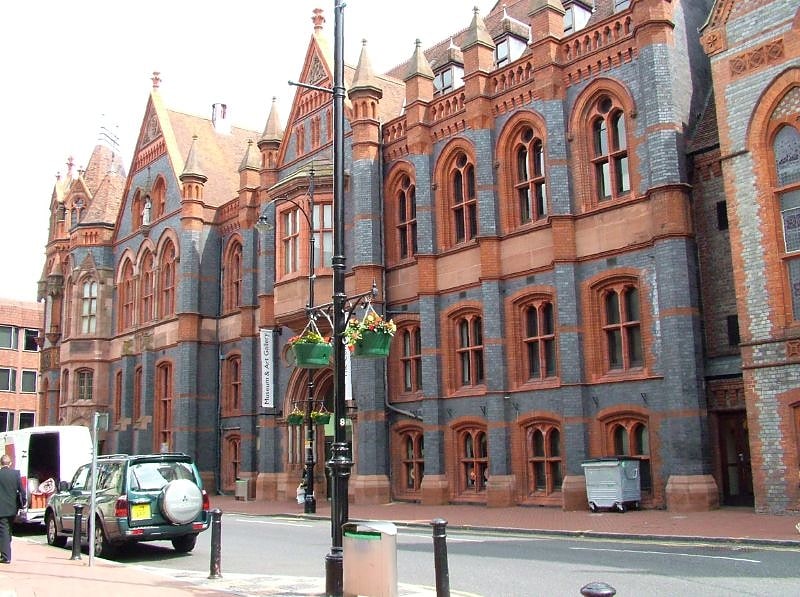
Museum in Reading, England. Reading Museum is a museum of the history of the town of Reading, in the English county of Berkshire, and the surrounding area. It is accommodated within Reading Town Hall, and contains galleries describing the history of Reading and its related industries, a gallery of artefacts discovered during the excavations of Calleva Atrebatum, a copy of the Bayeux Tapestry, finds relating to Reading Abbey and an art collection.[10]
Address: Town Hall Blagrave Street, RG1 1QH Reading
Beale Wildlife Park
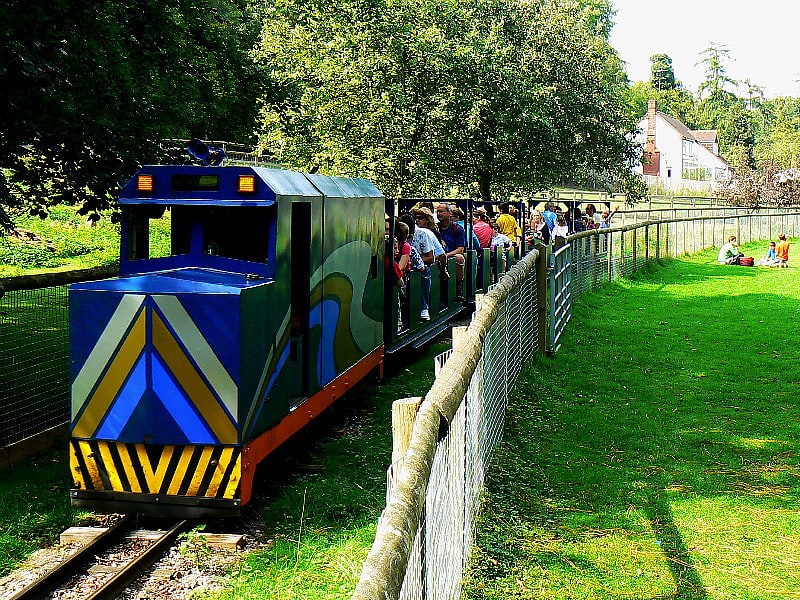
Wildlife park in England. Beale Wildlife Park is situated by the River Thames, between the villages of Pangbourne and Lower Basildon in Berkshire, England. It has three main areas of attraction: collections of small exotic animals, farm animals and birds; landscaped gardens and woodlands; and children's play areas.
In 1956, Beale Park was formed by Gilbert Beale who decided to give the 350-acre (140 ha) Thames-side park land to ‘the people’ by converting it from private farmland into a non-profit making, charitable trust. In those days it was little more than a track and a couple of ponds.[11]
Address: Lower Basildon, RG8 9NW Reading
St James's Church
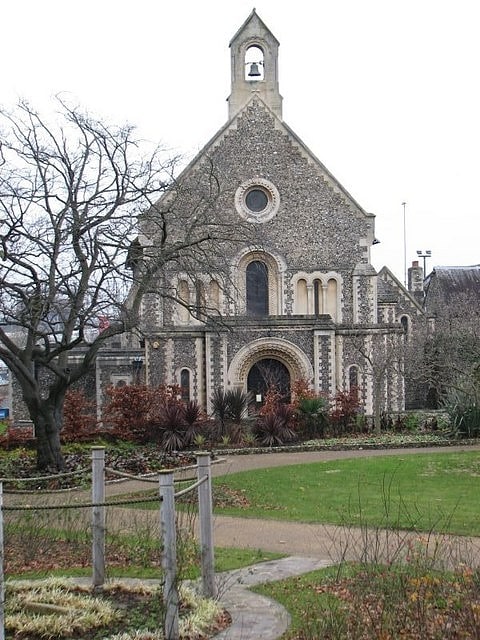
Catholic church in Reading, England. St James's Church is a Roman Catholic church situated in the centre of the town of Reading in the English county of Berkshire. The church is located next to Reading Abbey ruins, between the Forbury Gardens and Reading Gaol.
St James's Church continues the traditions of Reading Abbey in the post-Reformation era. Its founder was James Wheble, who owned land in the area at that time. The church was designed by the architect A. W. N. Pugin and is one of his first church designs. Parts of the church were built using stones from the Abbey ruins.
The design of the church is Norman, a style not normally associated with Pugin, and was probably influenced by the proximity of the Abbey ruins. The exterior of the building is of flint, with ashlar dressings and a Roman tile roof. Construction started in 1837 and the church opened on 5 August 1840. In 1925, the south aisle and the ambulatory round the apse were added. In 1962, the church was further extended by a north aisle into which was relocated the baptistery. The church is a Grade II listed building.
St James's Church, along with St William of York's Church, forms a joint parish within the Roman Catholic Diocese of Portsmouth. The current parish priest (since February 2010) is Canon John O'Shea. Sunday masses are well-attended often with standing room only; the parish boasts a large number of nationalities among its regular congregation.
Cardinal Cormac Murphy-O'Connor, Archbishop of Westminster from 2000 to 2009, was baptised in St James's and served at the altar there regularly as a boy.[12]
Address: Abbot's Walk, RG1 3HW Reading
Harris Garden
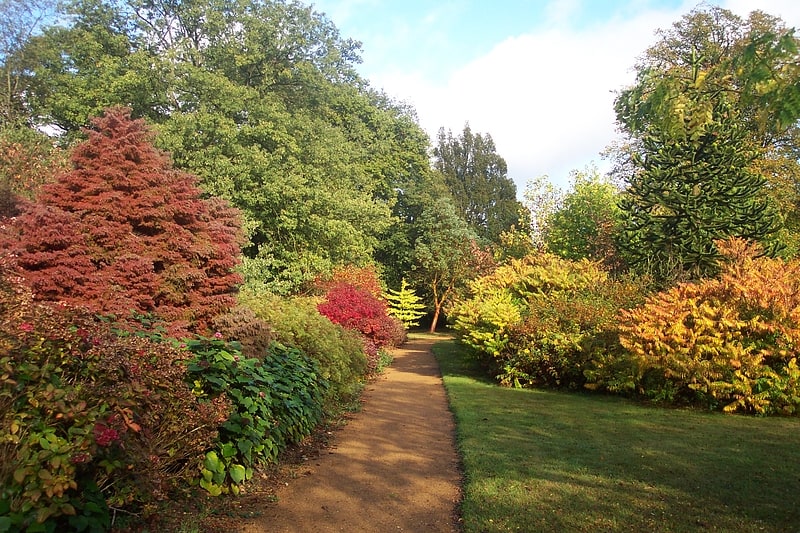
Garden in Reading, England. The Harris Garden is a botanical garden of the University of Reading, situated about 2 miles from the centre of the English town of Reading. It was established in 1972 and expanded into its current form in 1988. It is named after Professor Tom Harris, a distinguished palaeobotanist and keen gardener. Friends of the Harris Garden is an organisation set up with the aim of supporting the Garden.
The garden is situated on the Whiteknights Park campus of the university, but is separate from the rest of the parkland campus. It is accessed from the rest of the campus by an entrance behind the Harborne and Philip Lyle Buildings of the School of Biological Sciences.[13]
Address: University of Reading, RG6 6UR Reading
Bridge Street

Bridge Street, formerly known as Seven Bridges, is a historic street in the town of Reading in the English county of Berkshire. It took its original name from the seven bridges that carried it over various channels of the River Kennet, and was the earliest crossing place of that river in the town.
Bridge Street connects Southampton Street, formerly known as St Giles' Street, to the south, with St Mary's Butts to the north.[14]
Address: Bridge Street, Reading
Southcote Lock
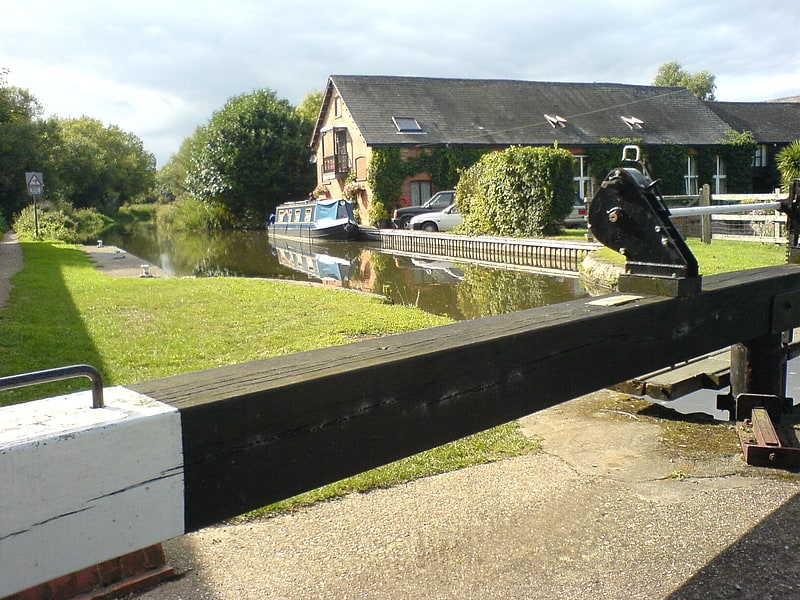
Cultural landmark in Reading, England. Southcote Lock is a lock on the River Kennet at Southcote near the town of Reading in Berkshire, England. It has a rise/fall of 5 feet 3 inches.[15]
King's Meadow

Park in Reading, England. King's Meadow is a park in Reading, Berkshire, England, located next to the River Thames. It stretches from the Coal Woodland to King's Meadow Road near Reading Bridge. King's Meadow is visible from the railway when entering or leaving Reading railway station from the eastern side. It is currently managed by Reading Borough Council.[16]
Caversham Court

Park in Reading, England. Caversham Court is a public garden and was a mansion located on the north bank of the River Thames in Caversham, a suburb of Reading in the English county of Berkshire. The park lies within the St Peter's conservation area. The park is listed as Grade II in the National Register of Historic Parks and Gardens.[17]
Address: Church Rd, Caversham, Reading
St Mary's Church
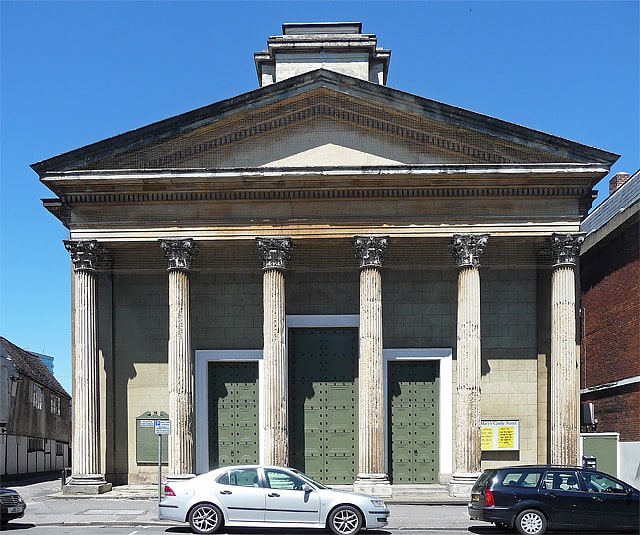
Church in Reading, England. St Mary's Church, Castle Street is an independent church within the Continuing Anglican movement. It is located in the town centre of Reading, in the English county of Berkshire, and is a few yards from the similarly named, but much older Minster Church of St Mary the Virgin.
In 1798, there was a disagreement between the Bishop and the congregation of St Giles' Church in nearby Southampton Street. Many of the congregation left and founded a new chapel in Castle Street, on the site of Reading's old gaol. This chapel eventually became the Church of St Mary, Castle Street.
The church is a Grade II* listed building. The original 1798 building was a simple Georgian building, but in 1840 the present hexastyle portico in Corinthian style was added by local architect and builder Henry Briant. The frontage is rendered in stucco while the capitals of the portico are probably formed of Coade stone.
The church has one of Reading's best church interiors, with a late-18th-century gallery in 5 bays with marbled Doric ground floor and Ionic gallery columns. There is a modillion cornice to the coved central ceiling and a small projecting chancel with a bay for the mid-19th-century organ. The instrument, by Vowles of Bristol, is dated 1870, and was moved to St Mary's from Bristol in 1987. The church used to be lit by two mid-19th-century cast iron chandeliers.
Today the church forms part of the Church of England (Continuing), a small group of four congregations outside the Church of England, self-identified on their website as "evangelical, reformed, Anglican".[18]
Address: 12 Castle St, RG1 7RD Reading
Greyfriars Church
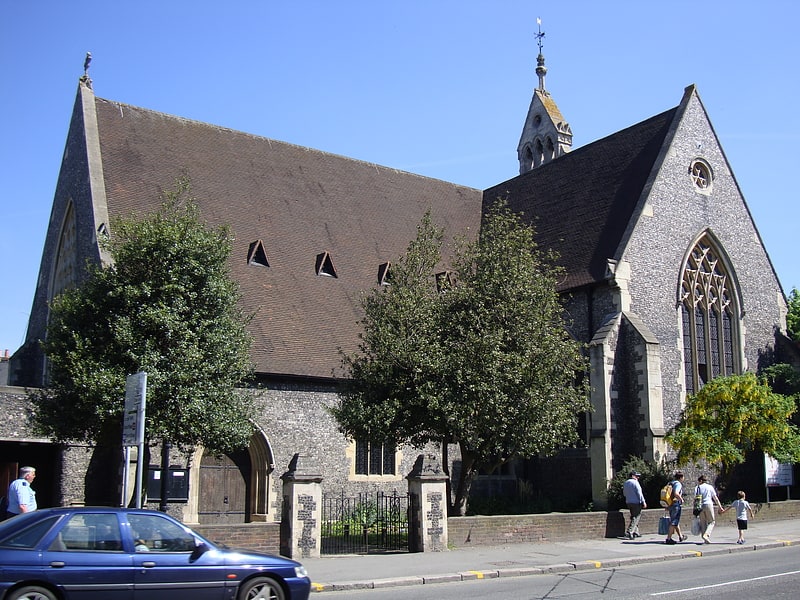
Church in Reading, England. Greyfriars Church is an evangelical Anglican church, and former Franciscan friary, in the town centre of Reading in the English county of Berkshire. The church forms part of the Church of England's Diocese of Oxford.
It is the oldest Franciscan church still in use as a place of worship in the UK, and is said to be the most complete surviving example of Franciscan architecture in England. As a consequence, it has been listed as a Grade I listed building.[19]
Address: Friar St, RG1 1EH Reading
Blake's Lock
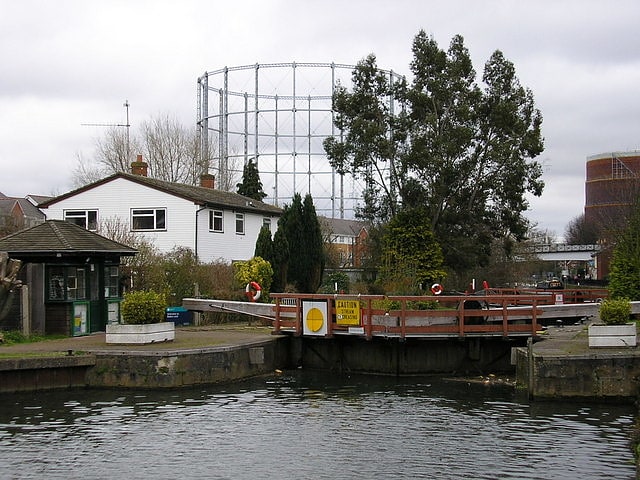
Blake's Lock is a lock situated on the River Kennet in Reading, Berkshire, England. It is on the short reach of the River Kennet which is administered as if it were part of the River Thames and is hence owned and managed by the Environment Agency.[20]
Prospect Park
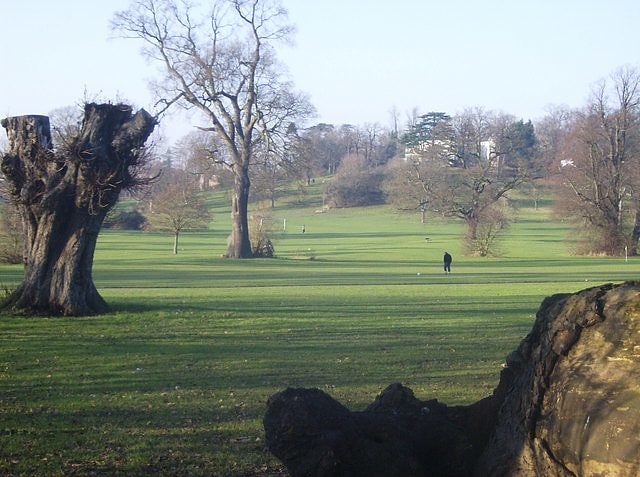
Park in Reading, England. Prospect Park is a public park in the western suburbs of Reading situated north of the Bath Road in the English county of Berkshire. It is the largest and most popular park in Reading, and includes a large regency style house, now known as Prospect Park Mansion House and previously as Prospect House. There are also sporting facilities and the Prospect Park Miniature Railway within the 50 hectares of parkland, and a restaurant in the Mansion House.
The park is listed as Grade II in the English Heritage Register of Historic Parks and Gardens whilst the Mansion House is a Grade II listed building.[21]
Address: Liebenrood Rd, RG30 2ND Reading
Statue of Queen Victoria
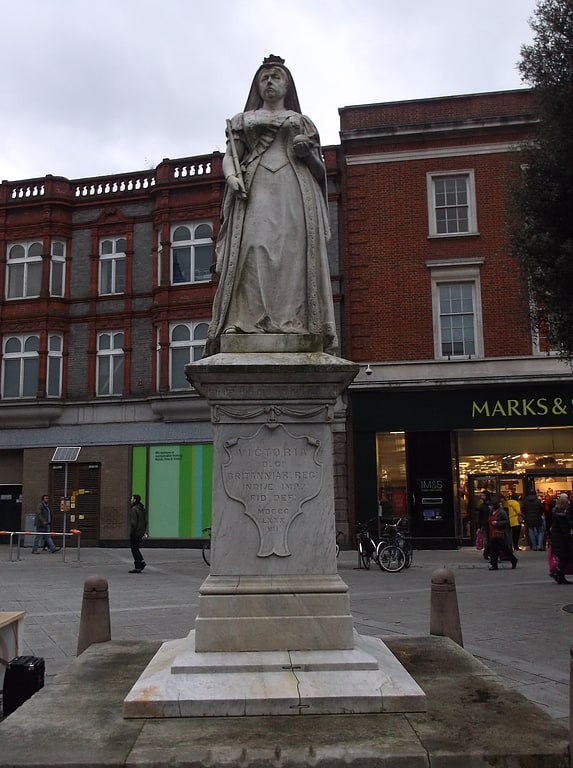
Monument in Reading, England. The statue of Queen Victoria stands at the western end of Friar Street outside the Town Hall of Reading, Berkshire, in southern England.[22]
Christchurch Bridge
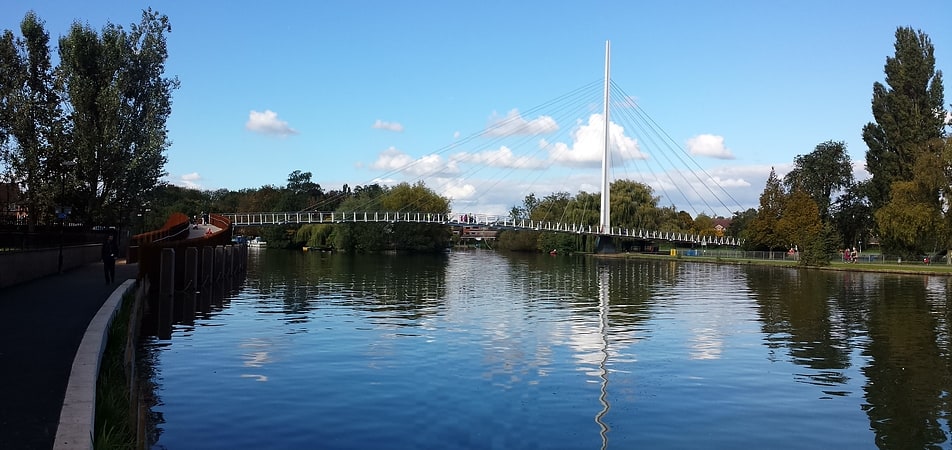
Cable-stayed bridge in Reading, England. Christchurch Bridge, originally known as the Reading Pedestrian and Cycle Bridge, is a pedestrian and cycle bridge over the River Thames at Reading in the English county of Berkshire. The bridge links the centre of Reading on the south bank with the cross-river suburb, and former village, of Caversham on the north bank. It crosses the river some 200 metres above Reading Bridge, and immediately downstream of Fry's Island.[23]
St Andrew's Church
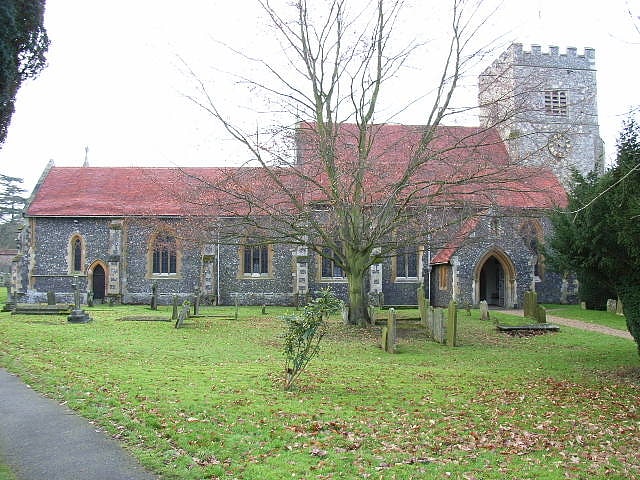
Church in Sonning, England. St Andrew's Church is Church of England parish church in a central position in the village of Sonning, close to the River Thames, in the English county of Berkshire. It is notable for its fine array of church monuments and for being the successor of an Anglo-Saxon Cathedral.[24]
Address: 6 Thames St, RG4 6UT Reading
Fobney Lock
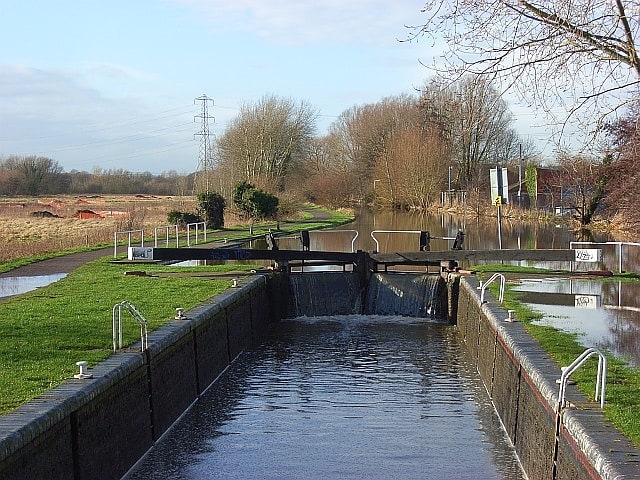
Fobney Lock is a lock on the River Kennet in the Small Mead area of Reading in the English county of Berkshire. Between the lock cut for the lock and the river itself is Fobney Island, which is a nature reserve.
Fobney Lock was built between 1718 and 1723 under the supervision of the engineer John Hore of Newbury, and this stretch of the river is now administered by Canal & River Trust and known as the Kennet Navigation. It has a rise/fall of 7 ft 8 in (2.24 m).
Fobney Island was transformed into a nature reserve in 2013, with the creation of wetland, a hay meadow and reed beds. It was intended that the resulting habitats would attract wildlife, including birds, bats, water voles, and otters.[25]
Riverside Museum at Blake's Lock
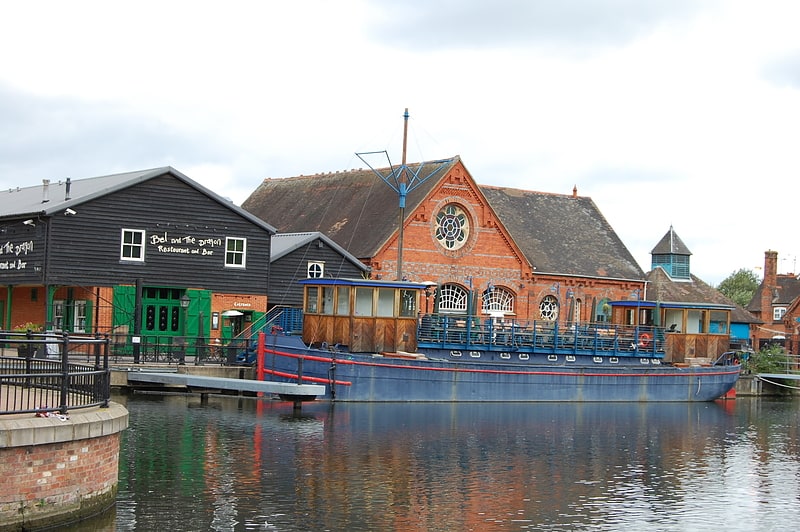
Museum in Reading, England. Riverside Museum at Blake's Lock is a museum located at Blake's Lock in the town of Reading, in the English county of Berkshire. The museum contains information about the history of human activity on the Kennet and the Thames rivers in Reading.
The museum is located in two historical buildings: the Screen House and the Turbine House. Exhibits include information about Romani people, examples of medieval uses of the river, and temporary art exhibits.[26]
Reading Minster
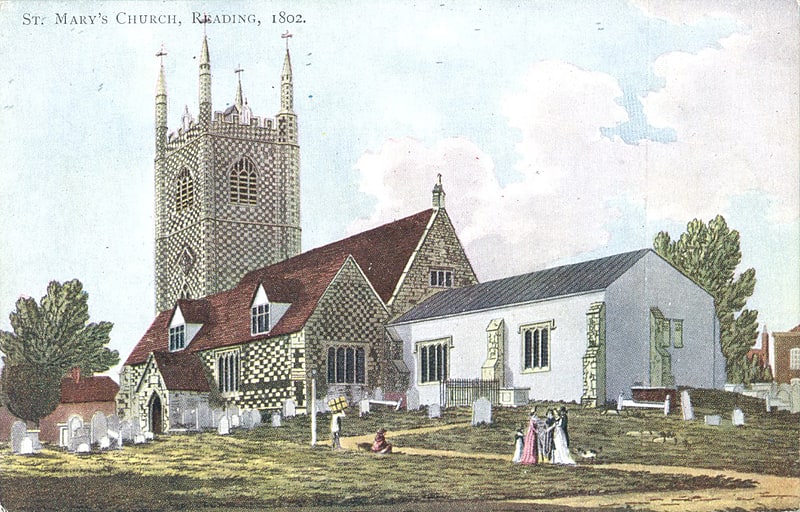
Reading Minster, or the Minster Church of St Mary the Virgin, is the oldest ecclesiastical foundation in the English town of Reading. Although eclipsed in importance by the later Reading Abbey, Reading Minster regained its status after the destruction of the Abbey and is now an Anglican parish church. The minster gives its name to the street of St Mary's Butts, on which it stands.
The Minster Church of St Mary the Virgin should not be mistaken for the similarly named St Mary's Church, Castle Street, which is only a few yards away.[27]
Address: Chain Steet, RG1 2HX Reading
Burghfield Lock

Cultural landmark in England. Burghfield Lock is a lock on the River Kennet at Burghfield in the English county of Berkshire.
Burghfield Lock was built between 1718 and 1723 under the supervision of the engineer John Hore of Newbury, and this stretch of the river is now administered by the Canal & River Trust and known as the Kennet Navigation. It has a rise/fall of 7 ft 0 in (2.13 m).
The lock was restored in 1968 by a collaboration involving staff from British Waterways and volunteer labour.[28]
Museum of English Rural Life
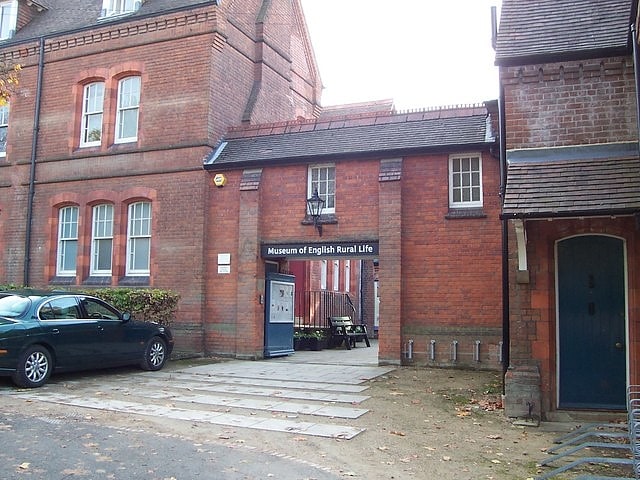
Museum in Reading, England. The Museum of English Rural Life, also known as The MERL, is a museum, library and archive dedicated to recording the changing face of farming and the countryside in England. The museum is run by the University of Reading, and is situated in Redlands Road to the rear of the institution's London Road Campus near to the centre of Reading in southern England. The location was formerly known as East Thorpe House and then St. Andrews Hall. It is an accredited museum and accredited archive as recognised by Arts Council England and the National Archives.[29]
Address: 6 Redlands Rd, RG1 5EX Reading
Museum of Berkshire Aviation

Museum in Woodley, England. The Museum of Berkshire Aviation is a small aviation museum in Woodley, a suburb of Reading in Berkshire, England. The museum is on the edge of the site of the former Woodley Aerodrome and many of its exhibits relate to the Phillips & Powis company, later renamed Miles Aircraft, which was based there from 1932 to 1947. Other aircraft exhibited were built by Handley Page Ltd, and by Fairey Aviation at White Waltham near Maidenhead.
Despite being a small museum, several of the exhibits are unique survivors. These include a Miles Martinet (a World War II target tug), the only Miles Student two-seat side-by-side jet trainer ever built, and a Fairey Jet Gyrodyne — a composite helicopter and autogyro, or gyrodyne.
Other exhibits include:
- A Fairey Gannet carrier-borne anti-submarine aircraft, formerly operated by the Royal Navy.
- A Handley Page Herald turboprop airliner, designed by Miles and built at Woodley after Handley Page took over Miles' aircraft contracts.
- A Miles Magister two-seat basic trainer aircraft.
Address: Mohawk Way, RG5 4UE Reading
Cole Museum of Zoology
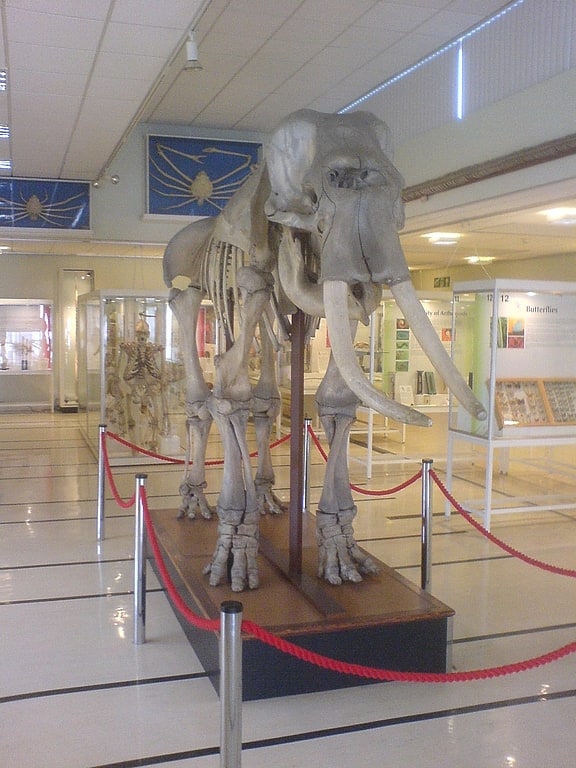
Museum in Reading, England. The Cole Museum of Zoology is a university museum, part of the School of Biological Sciences at the University of Reading. It is located on the university's Whiteknights Campus in the town of Reading, Berkshire, England.
The collection was established in the early 20th century by Francis J. Cole (Professor of Zoology), Dr Nellie B. Eales (who catalogued the collection), and Mr Stoneman, from 1907 to 1939 when Cole retired. On Cole's death in 1959, the University also purchased his library of books, which are kept as a special collection in the main library.
A refurbishment of the museum was completed on 17 March 2004, enlarging the floor area to display a wider sample of the entire collection. It contains about 4,000 specimens of which about 400 are on display at any one time. Specimens are arranged in 27 cases in taxonomic sequence, thus enabling a complete tour of the diversity of the animal kingdom. Specimens include a male Indian circus elephant skeleton, a 5-metre reticulated python skeleton containing 400 vertebrae, a fossil of the largest spider to ever have lived, and a false killer whale skeleton.[31]
Address: Ams Building, University of Reading, RG6 6AD Reading
Ure Museum of Greek Archaeology

Museum in Reading, England. The Ure Museum of Greek Archaeology contains one of the most important collections of Greek antiquities in the United Kingdom. The Museum forms part of the Department of Classics at the University of Reading and is situated on the university's Whiteknights Campus, about 2 miles from the centre of the English town of Reading, Berkshire. The museum is open to the public Tuesday to Friday and there is no admission charge.[32]
Address: University of Reading, RG6 6AA Reading
St Laurence's Church
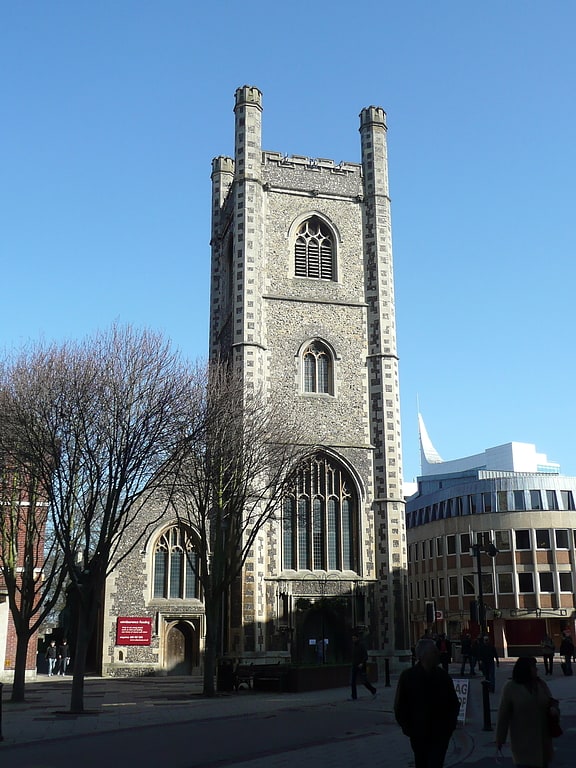
Church in Reading, England. St Laurence's Church is a Church of England mission and former parish church in the town of Reading in the English county of Berkshire. It is situated alongside the site of Reading Abbey, formerly bounded by the main Compter Gate to the south and the Hospitium of St John to the north. What was once the private chapel of the latter institution still remains in the north aisle.
The church is a Grade I listed building.[33]
Address: Friar Street, RG1 2DQ Reading
The Mill at Sonning
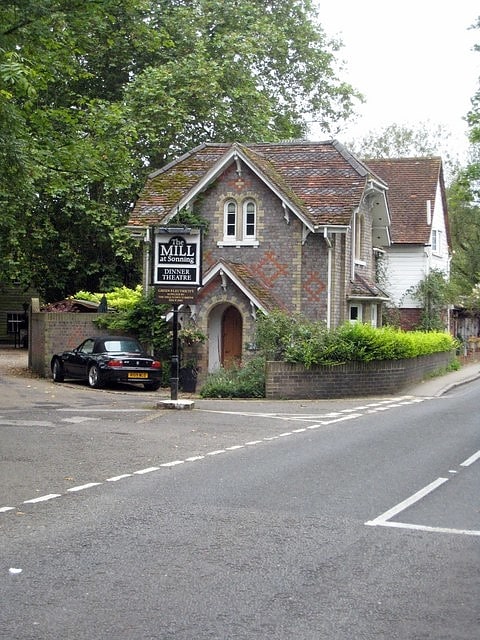
Theatre in Sonning Eye, England. The Mill at Sonning is a theatre and restaurant, converted from a circa-1800 flour mill on earlier foundations, on an island in the River Thames at Sonning Eye in the English county of Berkshire.
The river divides into three, with the mill race forming the middle branch, spanned by one of the Sonning Backwater Bridges just downstream of the mill. The original mill was established much earlier and was mentioned in the Domesday Book. During the 19th and early 20th centuries, the mill was owned by the well-known local families of May and Witherington, and it produced flour for Huntley and Palmer biscuits in the nearby town of Reading. More recently, the Mill complex has been converted into a 215-seat air-conditioned theatre, with a restaurant for pre-theatre meals and also a bar, where the original watermill is now exposed to view. Close by is the French Horn hotel, also on the river.
The theatre has a small hydroelectric generator of 18.5 kW capacity, commissioned in June 2005. This was the first such installation on the Thames, predating the one at Windsor Castle. In 1984, the Mill at Sonning was given a conservation award by The Times newspaper and the Royal Institution of Chartered Surveyors for the design, restoration and conversion of the derelict mill into a dinner theatre.
The theatre's first artistic director was Peter Egan. Productions have included performances by Anthony Valentine, Judi Dench, June Whitfield, Adam Faith, Michael Denison, Dulcie Gray, John Junkin and Brian Cant.
The Mill adjoins the Mill House, a circa-1800 house based on earlier foundations, acquired by the American film actor George Clooney and his wife, British human rights lawyer Amal Clooney, in 2014.[34]
Address: Sonning Eye, RG4 6TY Sonning on Thames
Whiteknights Park

Whiteknights Park, or the Whiteknights Campus of the University of Reading, is the principal campus of that university. The park covers the area of the manor of Earley Whiteknights, also known as Earley St Nicholas and Earley Regis.
Whiteknights Park is some two miles south of the centre of the town of Reading in the English county of Berkshire. The campus is 1.3 square kilometres (321 acres) in size and includes lakes, conservation meadows and woodlands as well as being home to most of the university's academic departments and several halls of residence.[35]
Address: 3sixty Reading University Campus, Reading